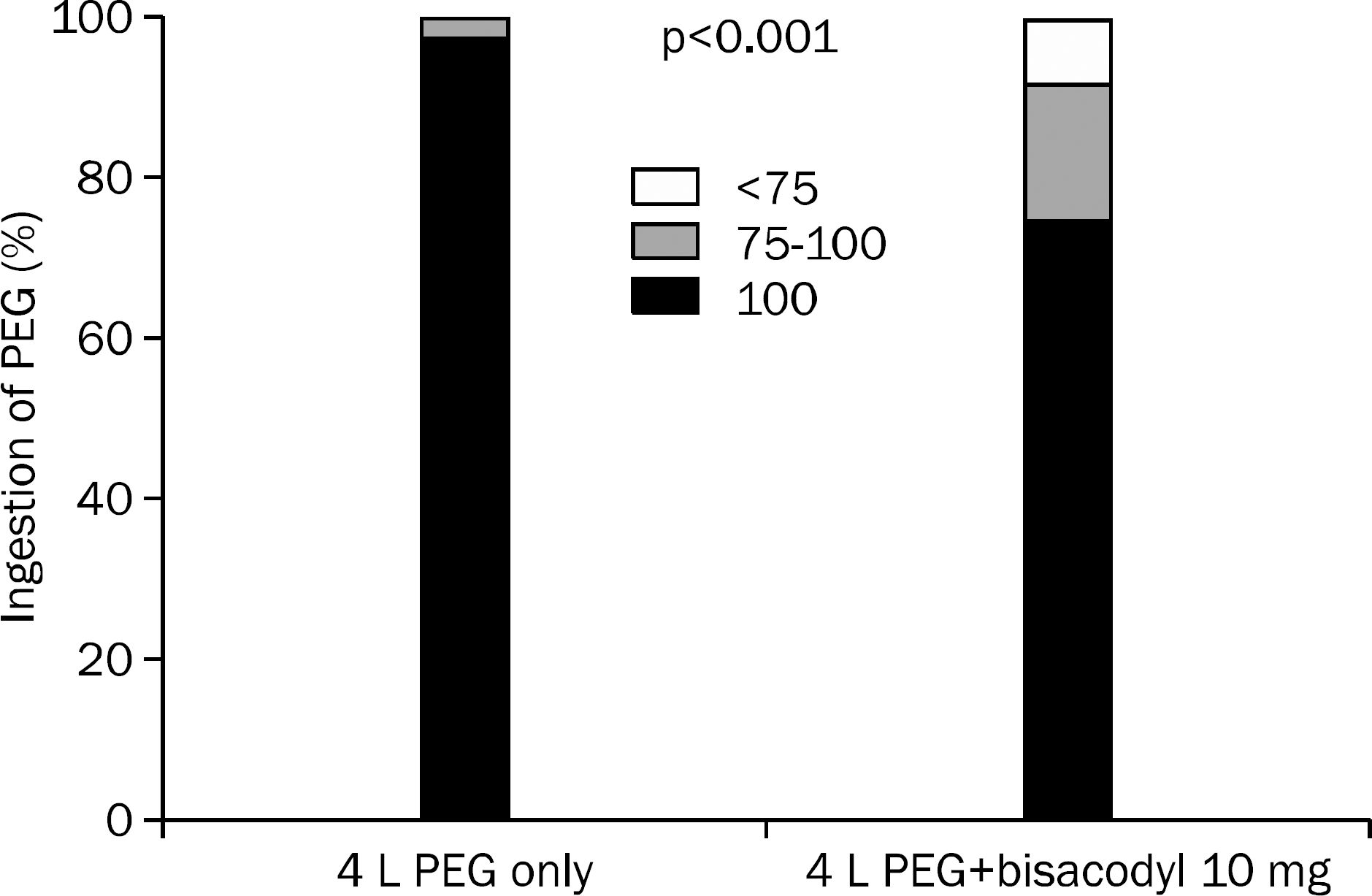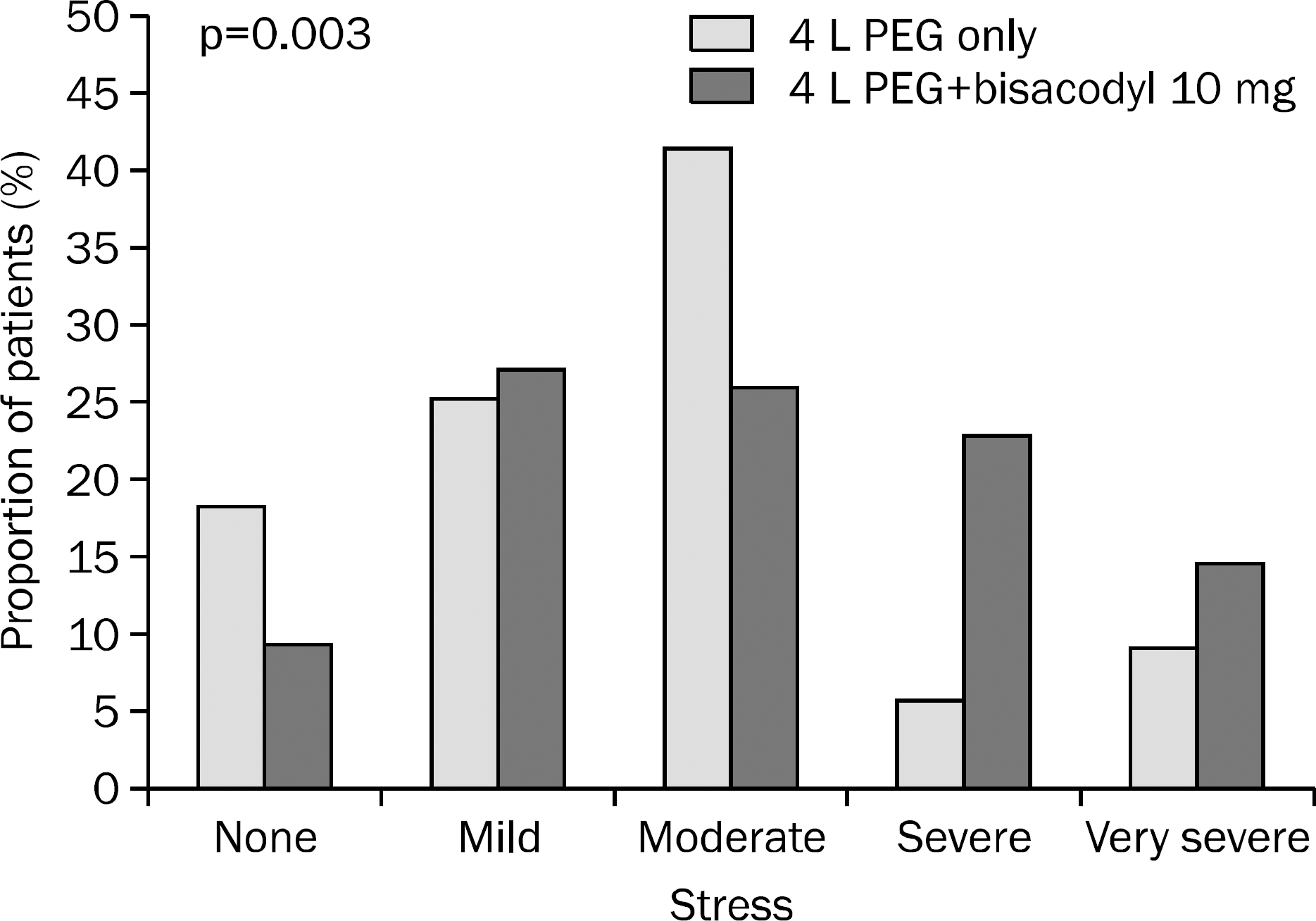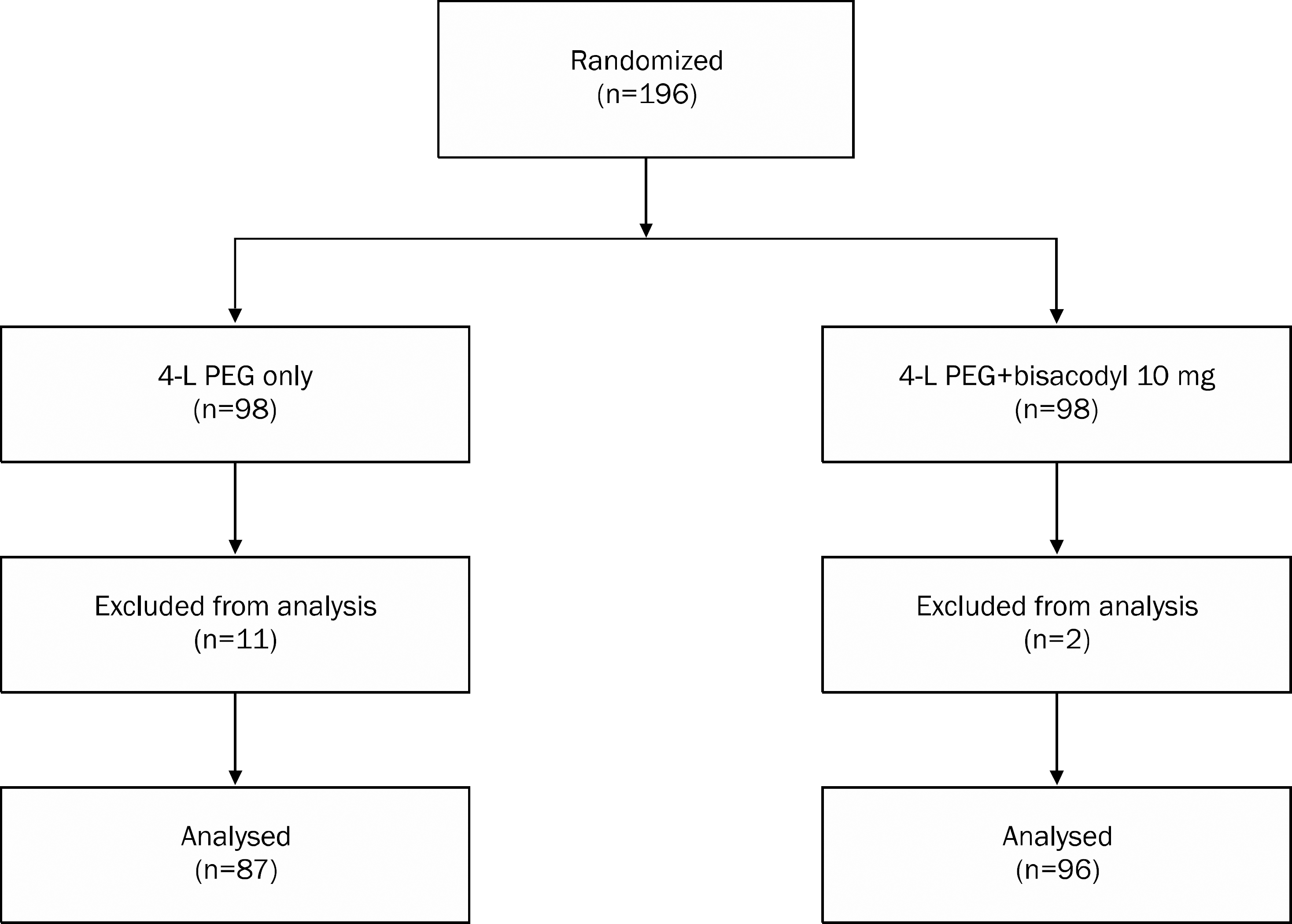Abstract
Background/Aims
Inpatient status can cause inadequate bowel preparation. The majority of previous studies regarding bowel preparation have focused on comparing the effects of different purgative regimens in outpatients. However, data on bowel preparation for inpatients are lacking. The aim of this study was to investigate whether bisacodyl plus polyethylene glycol (PEG) can improve bowel preparation in hospitalized patients.
Methods
A prospective, randomized and observer-blind study was performed. A total of 196 hospitalized patients undergoing colonoscopy were randomized to receive 4 L PEG (PEG only group) or 4 L PEG+ bisacodyl 10 mg (bisacodyl added group). The adequacy of bowel preparation was scored using the Ottawa bowel preparation scale.
Results
One hundred and eighty-three subjects completed the study; 96 in the bisacodyl added group and 87 in the PEG only group. There were no significant differences between the bisacodyl added group and the PEG only group with respect to the score of bowel cleansing (3.59±2.81 vs. 3.82±3.03, p=0.607), quality of bowel cleansing (adequate preparation 89.6% vs. 85.1%, p=0.380), and overall adverse events (66.7% vs. 52.9%, p=0.057). However, a larger proportion of patients in the PEG only group were able to ingest the entire solution as prescribed than in the bisacodyl added group (98.9% vs. 75.0%, p<0.001).
Go to : 
References
1. Sung JJ, Lau JY, Goh KL, Leung WK. Asia Pacific Working Group on Colorectal Cancer. Increasing incidence of colorectal cancer in Asia: implications for screening. Lancet Oncol. 2005; 6:871–876.

2. Zauber AG, Winawer SJ, O'Brien MJ, et al. Colonoscopic polypectomy and long-term prevention of colorectal-cancer deaths. N Engl J Med. 2012; 366:687–696.

3. Kim WH, Cho YJ, Park JY, Min PK, Kang JK, Park IS. Factors affecting insertion time and patient discomfort during colonoscopy. Gastrointest Endosc. 2000; 52:600–605.

4. Rex DK, Imperiale TF, Latinovich DR, Bratcher LL. Impact of bowel preparation on efficiency and cost of colonoscopy. Am J Gastroenterol. 2002; 97:1696–1700.

5. Wexner SD, Beck DE, Baron TH, et al. American Society of Colon and Rectal Surgeons; American Society for Gastrointestinal Endoscopy; Society of American Gastrointestinal and Endoscopic Surgeons. A consensus document on bowel preparation before colonoscopy: prepared by a task force from the American Society of Colon and Rectal Surgeons (ASCRS), the American Society for Gastrointestinal Endoscopy (ASGE), and the Society of American Gastrointestinal and Endoscopic Surgeons (SAGES). Gastrointest Endosc. 2006; 63:894–909.

6. Belsey J, Epstein O, Heresbach D. Systematic review: oral bowel preparation for colonoscopy. Aliment Pharmacol Ther. 2007; 25:373–384.

7. Mamula P, Adler DG, Conway JD, et al. Asge Technology Committee. Colonoscopy preparation. Gastrointest Endosc. 2009; 69:1201–1209.

8. Ness RM, Manam R, Hoen H, Chalasani N. Predictors of inadequate bowel preparation for colonoscopy. Am J Gastroenterol. 2001; 96:1797–1802.

9. Chorev N, Chadad B, Segal N, et al. Preparation for colonoscopy in hospitalized patients. Dig Dis Sci. 2007; 52:835–839.

10. Reilly T, Walker G. Reasons for poor colonic preparation with inpatients. Gastroenterol Nurs. 2004; 27:115–117.

11. Hendry PO, Jenkins JT, Diament RH. The impact of poor bowel preparation on colonoscopy: a prospective single centre study of 10,571 colonoscopies. Colorectal Dis. 2007; 9:745–748.

12. Rosenfeld G, Krygier D, Enns RA, Singham J, Wiesinger H, Bressler B. The impact of patient education on the quality of inpatient bowel preparation for colonoscopy. Can J Gastroenterol. 2010; 24:543–546.

13. Tae JW, Lee JC, Hong SJ, et al. Impact of patient education with cartoon visual aids on the quality of bowel preparation for colonoscopy. Gastrointest Endosc. 2012; 76:804–811.

14. Brady CE 3rd, Dipalma JA, Beck DE. Effect of bisacodyl on gut lavage cleansing for colonoscopy. Ann Clin Res. 1987; 19:34–38.
15. Hara AK, Kuo MD, Blevins M, et al. National CT colonography trial (ACRIN 6664): comparison of three full-laxative bowel preparations in more than 2500 average-risk patients. AJR Am J Roentgenol. 2011; 196:1076–1082.

16. El Sayed AM, Kanafani ZA, Mourad FH, et al. A randomized single-blind trial of whole versus split-dose polyethylene glycol-elec-trolyte solution for colonoscopy preparation. Gastrointest Endosc. 2003; 58:36–40.

17. Ell C, Fischbach W, Bronisch HJ, et al. Randomized trial of low-vol-ume PEG solution versus standard PEG + electrolytes for bowel cleansing before colonoscopy. Am J Gastroenterol. 2008; 103:883–893.

18. DiPalma JA, McGowan J, Cleveland MV. Clinical trial: an efficacy evaluation of reduced bisacodyl given as part of a polyethylene glycol electrolyte solution preparation prior to colonoscopy. Aliment Pharmacol Ther. 2007; 26:1113–1119.

19. Adams WJ, Meagher AP, Lubowski DZ, King DW. Bisacodyl reduces the volume of polyethylene glycol solution required for bowel preparation. Dis Colon Rectum. 1994; 37:229–233.

20. Sharma VK, Chockalingham SK, Ugheoke EA, et al. Prospective, randomized, controlled comparison of the use of polyethylene glycol electrolyte lavage solution in four-liter versus two-liter vol-umes and pretreatment with either magnesium citrate or bisacodyl for colonoscopy preparation. Gastrointest Endosc. 1998; 47:167–171.

21. DiPalma JA, Wolff BG, Meagher A, Cleveland MV. Comparison of reduced volume versus four liters sulfate-free electrolyte lavage solutions for colonoscopy colon cleansing. Am J Gastroenterol. 2003; 98:2187–2191.

22. Corporaal S, Kleibeuker JH, Koornstra JJ. Low-volume PEG plus ascorbic acid versus high-volume PEG as bowel preparation for colonoscopy. Scand J Gastroenterol. 2010; 45:1380–1386.

23. Jansen SV, Goedhard JG, Winkens B, van Deursen CT. Preparation before colonoscopy: a randomized controlled trial comparing different regimes. Eur J Gastroenterol Hepatol. 2011; 23:897–902.
24. Valiante F, Pontone S, Hassan C, et al. A randomized controlled trial evaluating a new 2-L PEG solution plus ascorbic acid vs 4-L PEG for bowel cleansing prior to colonoscopy. Dig Liver Dis. 2012; 44:224–227.

25. Park S, Lim YJ. Adjuncts to colonic cleansing before colonoscopy. World J Gastroenterol. 2014; 20:2735–2740.

26. B⊘rkje B, Pedersen R, Lund GM, Enehaug JS, Berstad A. Effectiveness and acceptability of three bowel cleansing regimens. Scand J Gastroenterol. 1991; 26:162–166.
27. Brahmania M, Ou G, Bressler B, et al. 2 L versus 4 L of PEG3350 + electrolytes for outpatient colonic preparation: a randomized, controlled trial. Gastrointest Endosc. 2014; 79:408–416.

28. Huppertz-Hauss G, Bretthauer M, Sauar J, et al. Polyethylene glycol versus sodium phosphate in bowel cleansing for colonoscopy: a randomized trial. Endoscopy. 2005; 37:537–541.

29. Hjelkrem M, Stengel J, Liu M, Jones DP, Harrison SA. MiraLAX is not as effective as GoLytely in bowel cleansing before screening colonoscopies. Clin Gastroenterol Hepatol. 2011; 9:326–332.

30. Gerard DP, Holden JL, Foster DB, Raiser MW. Randomized trial of gatorade/polyethylene glycol with or without bisacodyl and NuLYTELY for colonoscopy preparation. Clin Transl Gastroenterol. 2012; 3:e16.

31. Moon CM, Park DI, Choe YG, et al. Randomized trial of 2-L polyethylene glycol + ascorbic acid versus 4-L polyethylene glycol as bowel cleansing for colonoscopy in an optimal setting. J Gastroenterol Hepatol. 2014; 29:1223–1228.
Go to : 
 | Fig. 2.Comparison of polyethylene glycol (PEG) ingestion between the two groups. The amount of ingested PEG was significantly greater in the 4 L PEG only group than in the 4 L PEG+bisacodyl group (p <0.001). |
 | Fig. 3.Patients’ stress to the bowel preparation. 4 L PEG+ bisacodyl 10 mg group suffered more severe stress than 4 L PEG only group (p=0.003). |
Table 1.
Baseline Characteristics of the Patients
Table 2.
Adequacy of Bowel Cleansing according to the Ottawa Bowel Preparation Scale
Table 3.
Comparison between Morning Colonoscopy and Afternoon Colonoscopy according to the Ottawa Bowel Preparation Scale
Table 4.
Quality Indicators of Adequate Colonoscopy
Table 5.
Adverse Effects of Bowel Preparation




 PDF
PDF ePub
ePub Citation
Citation Print
Print



 XML Download
XML Download